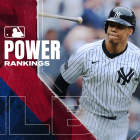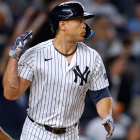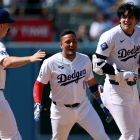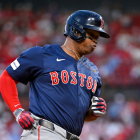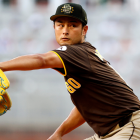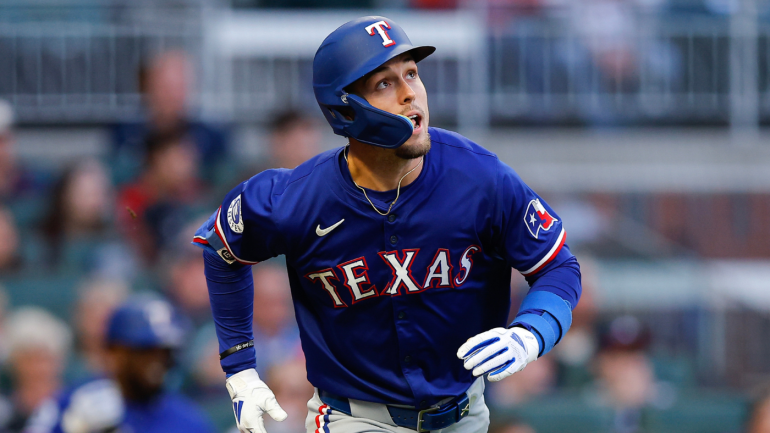
The Minor League Baseball season is now more than a month old. As such, it's about time that we get back to evaluating and analyzing what's happening with farm systems across the land. In other words, it's time for Prospect Watch to return.
For those new to the Prospect Watch feature, we run it on the first two Fridays of each month. One piece focuses on the National League (you can find that here), the other on the American League. We almost always have a single theme. Take this edition of Prospect Watch, where we'll be checking in on how each AL club's No. 1 prospect has fared thus far this season. (Do note that we're going off our offseason rankings; not all of these players would necessarily be their team's top prospect if we ranked them again now.)
Simple enough, right? Now, let's get to the good stuff.
| 1 | |
| MIF Jackson Holliday: You've surely read more about Holliday than any other player included in this article. He entered the spring ranked as our No. 1 prospect, and then earned an early season promotion to the majors. Alas, Holliday's introduction to The Show didn't go as planned. He was demoted after a 2-for-34 start. Clearly he has some adjustments to make. We're confident that he'll return to the big leagues at some point this summer in a better position to succeed. | |
| 2 | |
| OF Roman Anthony: At the time of the ranking, we praised Anthony's combination of youth, strength, and on-base skills while noting that he would likely need to lift the ball more frequently in order to maximize his slugging output. It's interesting, then, that his production has cratered despite him posting a career-low ground-ball percentage. The culprit, as best as we can tell? A lack of pulled fly balls. We'll see if he can start wearing out right field over the coming months. | |
| 3 | |
| SS Colson Montgomery: Often compared to Rangers star Corey Seager because of their slight facial resemblance, Montgomery sure hasn't looked like Seager at Triple-A. His strikeout rate is up over 30%, the product of him whiffing on more than 32% of his swings against four-seam fastballs. Montgomery is swinging through a lot of fastballs over the middle and up above the zone for someone of his pedigree. It's not what you want from one of the game's top prospects, especially not when they should be closing in on making their big-league debut. | |
| 4 | |
| 1B Kyle Manzardo: Last summer's return on Aaron Civale, Mazardo was recently bumped to the majors after an impressive showing in Triple-A. Over the course of 29 games, he batted .303/.375/.642 with nine home runs (six of which exited to either left or center feld). The biggest knock on Manzardo has been that he hasn't produced the kind of high-end exit velocities teams desire from their first basemen. Let's be clear, though, that we're not talking about Nolan Schanuel levels of pop. Manzardo topped out at about 109 mph in Triple-A, a mark that would rank 28th among 34 qualified first basemen -- between Michael Busch and Spencer Torkelson. Given Manzardo's feel for the zone and the barrel, we think he has enough juice to have a solid career. | |
| 5 | |
| 2B Colt Keith: Keith has spent the season in the majors after inking a long-term extension prior to his debut. He's yet to display the offensive potency that convinced the Tigers to make that deal. Instead, Keith is wearing out the right side of the infield with ground balls. He's done a fine job of making contact and maintaining the strike zone, but it's fair to write that the Tigers expected more oomph than they've received -- he collected two extra-base hits in his first 31 games. Keith isn't much of a defender or baserunner, so he's going to have to start hitting at some point. | |
| 6 | |
| SS Brice Matthews: Houston's first-round pick last summer by way of Nebraska, Matthews hasn't played since late April because of a back issue. That ailment might explain why he showed a surprising lack of pop over his first 10 games. A hearty and hale Matthews should provide the Astros with an intriguing power-speed combination. The catch is that he's struck out a little too frequently as a professional for our tastes given that he's a collegiate batter facing A-ball competition. | |
| 7 | |
| C Blake Mitchell: First-round prep catchers have a miserable track record, but that didn't stop the Royals from selecting Mitchell with the eighth pick last summer. He's already showing off his above-average pop and his willingness to work deep counts, launching nine extra-base hits and securing 22 walks in his first 23 games. He's also struck out in more than 36% of his plate appearances, so clearly there's still some room for improvement. | |
| 8 | |
| 1B Nolan Schanuel: We're not sure this is going to work. Schanuel, a landlocked first baseman, has the lowest maximum exit velocity in the majors among qualified hitters. Worse than Nicky Lopez, worse than Steven Kwan, worse than Sal Frelick, worse than, well, you get the point. Through his first 60 big-league games, he's homered four times and has a .078 ISO. Do you remember how people used to deride James Loney for his lack of slugging? Loney's career ISO was .126; his single-season worst mark was, get this, .078 … and that near the end of his big-league stay. We're mindful of the fact that Schanuel is only 22 and that he was rushed to the majors. Maybe he can add some strength over the coming years. For now, though, it's hard to be optimistic about his long-term prospects. | |
| 9 | |
| OF Walker Jenkins: Jenkins, the No. 5 pick in last summer's draft, injured his hamstring after taking one at-bat on Opening Day. (For those wondering, he struck out.) Check back when he gets a clean bill of health. | |
| 10 | |
| OF Jasson Domínguez: Speaking of which, Domínguez has not played this season after undergoing Tommy John surgery late last year. He's expected to begin a rehab assignment over the coming weeks. | |
| 11 | |
| RHP Mason Miller: We noted in Miller's ranking writeup that he had "massive stuff" as well as "massive injury concerns." The Athletics moved him to the bullpen in spring, presumably in an effort to reduce his physical workload. Whether or not that keeps him healthier is to be seen, but he's clearly a natural at the role. Miller has amassed a 1.26 ERA (309 ERA+) and a 7.25 strikeout-to-walk ratio through his first 12 appearances. We can only hope that he avoids the shelf, because he's already one of the game's most electric pitchers. | |
| 12 | |
| C Harry Ford: You've probably read this tidbit from us before, but we feel obligated to reprint it here: a first-round prep catcher has not remained behind the plate and authored a solid big-league career in more than two decades. (Joe Mauer being the last one.) Ford has, in our opinion, the best chance at ending that drought. He's off to a quality start at Double-A, the level that tends to separate the dudes from the Dudes, showing power and walking nearly as often as he's struck out as a 21-year-old. He's also a good athlete who continues to make progress behind the plate. Teams almost always regret going the prep catcher route early; the Mariners surely do not, not at this stage anyway. | |
| 13 | |
| 3B Junior Caminero: Caminero missed some time at the beginning of the season after suffering a quad injury. In his first 15 games since coming back, he's batted .312/.364/.639 with five home runs and five doubles. That'll play. It seems like only a matter of time before the Rays press the button and add Caminero to their big-league lineup. | |
| 14 | |
| OF Evan Carter: Carter, the breakout star of last October, continues to perform at an above-average clip thanks to an outstanding eye and feel for the barrel. We would be remiss if we didn't mention how valuable his baserunning has been thus far in his big-league career. Carter remains perfect on stolen-base attempts (five for five) and has taken the extra bag during the run of play an astounding 56% of the time. For reference, the league-average clip is usually around 40%. The only blemish on Carter's game is his lack of home-run thump. Something tells us the Rangers don't mind given everything else he brings to the table. | |
| 15 | |
| LHP Ricky Tiedemann: Tiedemann hasn't pitched since April 11 after being diagnosed with ulnar nerve inflammation. In three Triple-A appearances prior to the injury, he showed off a mid-90s fastball and a sweeping slider that generated more than 45% whiffs. Health has been a problem for Tiedemann throughout his professional career (he's thrown 130 innings since being drafted in 2021), to the extent that it's worth wondering if his future will come in a relief role. For now, the Blue Jays have every reason to keep starting him. | |





























